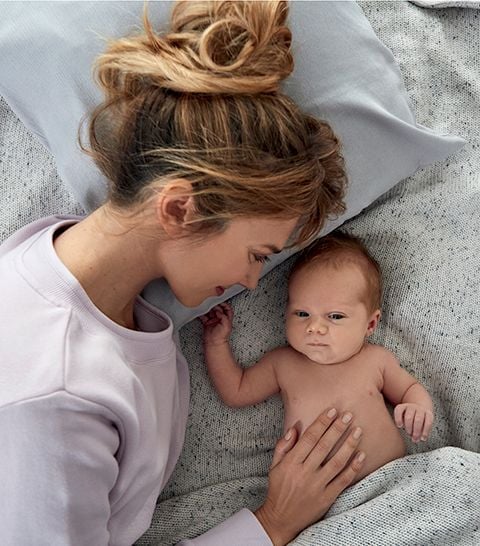
The Original Bibs Pacifier
As a bestseller for more than 40 years, the Original Bibs Pacifier is an iconic product trusted by parents worldwide. It features a natural soft latex cherry-shaped nipple and a lightweight shield that is designed to be the similar shape as a mother’s breast. Recommended by midwives, it supports natural breastfeeding as its shape and size helps your little one with the right sucking technique at the breast.
Bibs pacifiers are available in a variety of shades, prints and patterns that will put a smile on all fashion-savvy mothers. The Denmark-based brand also makes pacifier clips that attach to a piece of your child’s clothing, preventing it from getting lost.

Tommee Tippee Breast-like Soother
Inspired by Tommee Tippee’s award-winning Closer to Nature teat, these Breast-like Soothers are the next best thing when a mother’s breast isn’t available. They are made from super soft silicone that feels, moves, flexes and stretches just like human skin so your little one doesn’t get confused during switches to breast or bottle. This ensures that pacifiers don’t disrupt your little one’s breastfeeding or bottlefeeding experience.
The Breast-like Soother also supports oral development. Its symmetrical shape allows your baby’s tongue and jaw to rest in the correct position so as to allow natural and healthy development of teeth and gums. Additionally, the pacifier’s design is fully reversible, therefore it’ll be placed correctly into your baby’s mouth even if they do it themselves.
Frida Baby Paci Weaning System
This 5-steps Paci Weaning System by Frida Babby helps the baby say goodbye to their binkies. Each pacifier is progressively shorter than the previous one (and less satisfying) so that they give it up on their own will, without shedding any tears. This dentist designed product is most effective for toddlers under 12 months, and features silicone nipples that are latex and BPA free.

How to Choose a Pacifier for your Baby?
Choosing a pacifier for your baby is a trial-and-error process. While you may like a certain brand and style, your little one might have a different choice altogether. Allow them to take a pick between designs or colours, but when it comes to their safety and wellbeing keep the below in mind when buying a soother.
Construction
Your baby’s pacifier should meet safety standards recommended by authorities to avoid any accidents. It should have a one-piece construction, a soft nipple, a shield with air holes and be dish-washer safe. Binkies with complicated designs such as a removable moustache or similar plastic elements can fall off and pose a safety risk. The pacifier shield should also be at least 1 and ½ inches across so that the baby cannot fit it inside their mouth.
Shape
There are three typical shapes of a pacifier. The standard one has a straight, elongated and cylindrical nipple, a cherry-shaped pacifier has a trunk that becomes ball-shaped towards the end and orthodontic pacifiers have a rounded top and a flat bottom.
Size
Pacifiers become bigger as your child grows up. Always check the age recommendation on the products to make sure your little one is comfortable.
Material
Most pacifiers on the market are made from either latex or silicone. While the former is softer and more flexible, it is not recommended to use over a long period of time as it deteriorates quickly. On the other hand, silicone soothers are more durable, are dishwasher-friendly and don’t retain odours. For this reason, all of our selected pacifiers are made from BPA-free silicone.

When is the Best Time to Introduce a Pacifier?
If you are breastfeeding your baby, it is best to wait 3-4 weeks until the routine is established before introducing a pacifier. This is because the sucking action on a nipple and binky are different. By leaving some gap between the two activities, you will let your baby adjust completely to one before starting with the other and avoid confusion. In case you are bottlefeeding, pacifiers can be introduced at any time.
How Long Should a Baby Use a Pacifier in a Day?
Restrict your baby’s pacifier use after about 6 hours in a day. This way, your child will not get overly attached to it and can be weaned off relatively easily when time comes.
How Many Pacifiers Do I Need?
Babies tend to throw their pacifiers or leave them around the house while playing, therefore it is best to have a collection of their favourite ones handy. This way if one gets lost you will have a few spare ones to get through the day. A few extra pacifiers will also be helpful in case one gets lost, is in for washing or you simply want to match them with your baby’s outfit.
What Age Should Babies Not Use a Pacifier?
While there is no strict age limit when it comes to weaning babies off pacifiers, doctors and experts recommend stopping using a soother by their first birthday. Most kids give up pacifiers themselves between the ages of 2 and 4. However, if your child needs help to break the habit, you can do so by praising them whenever they are not using one or keeping them distracted with toys and games instead.








